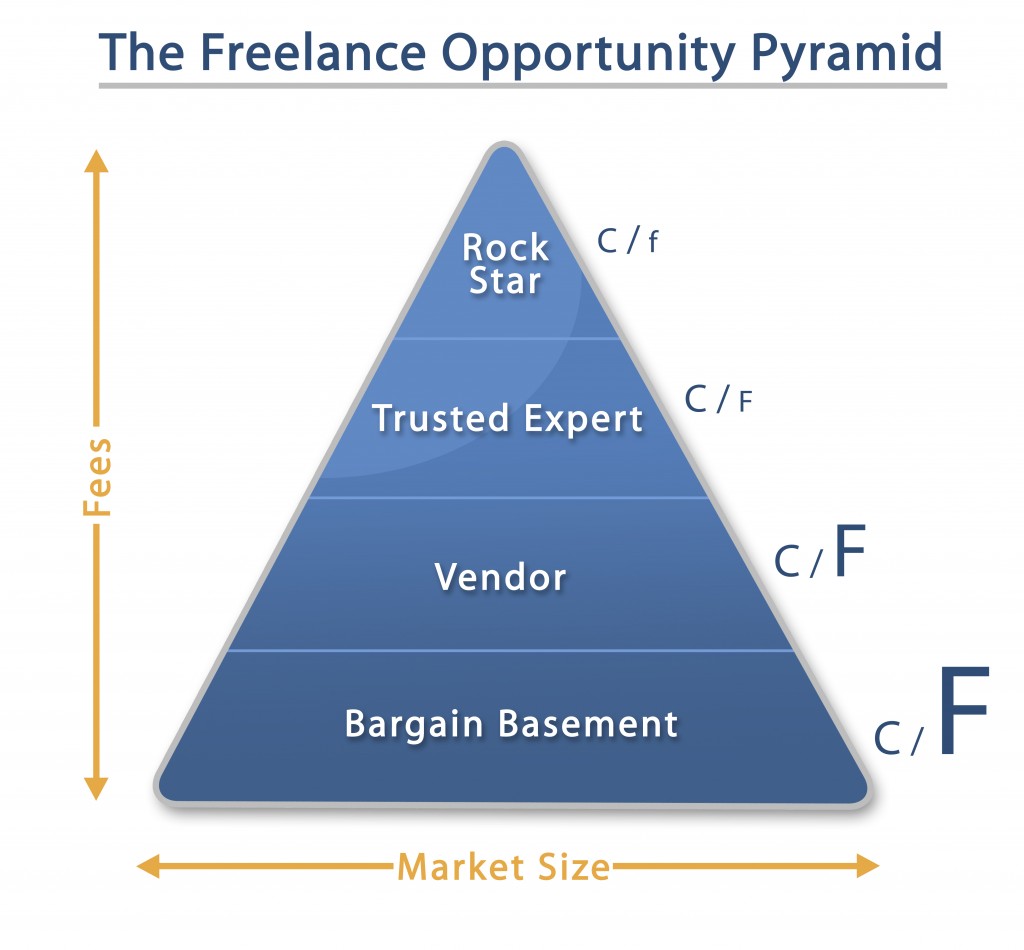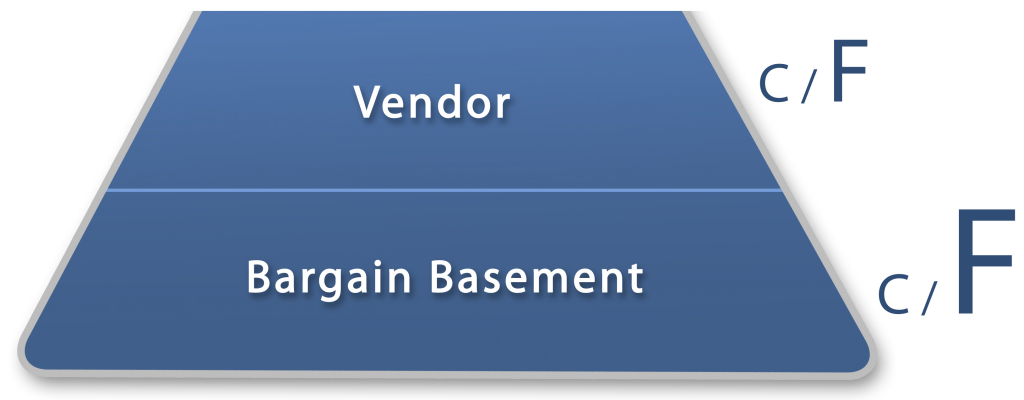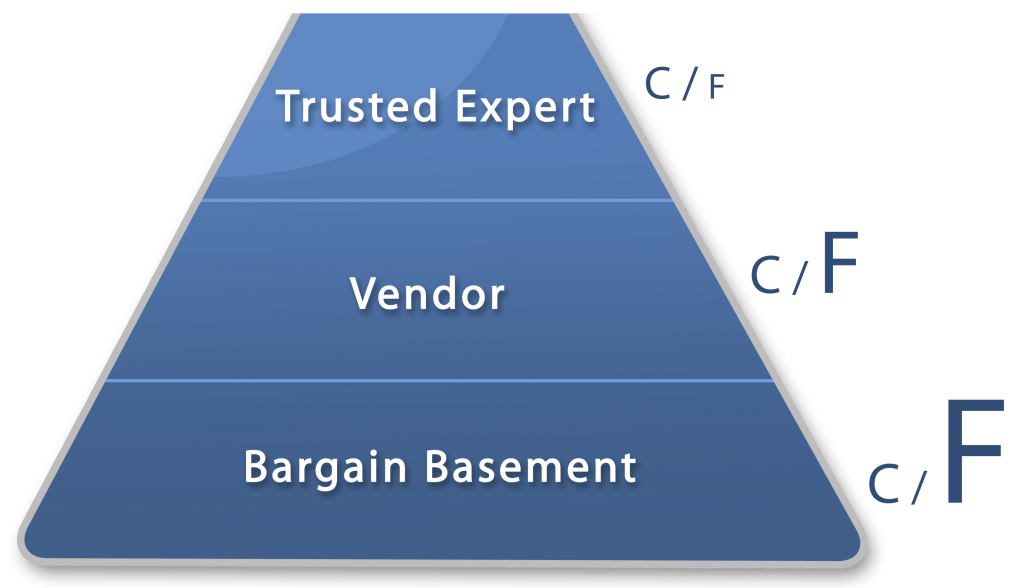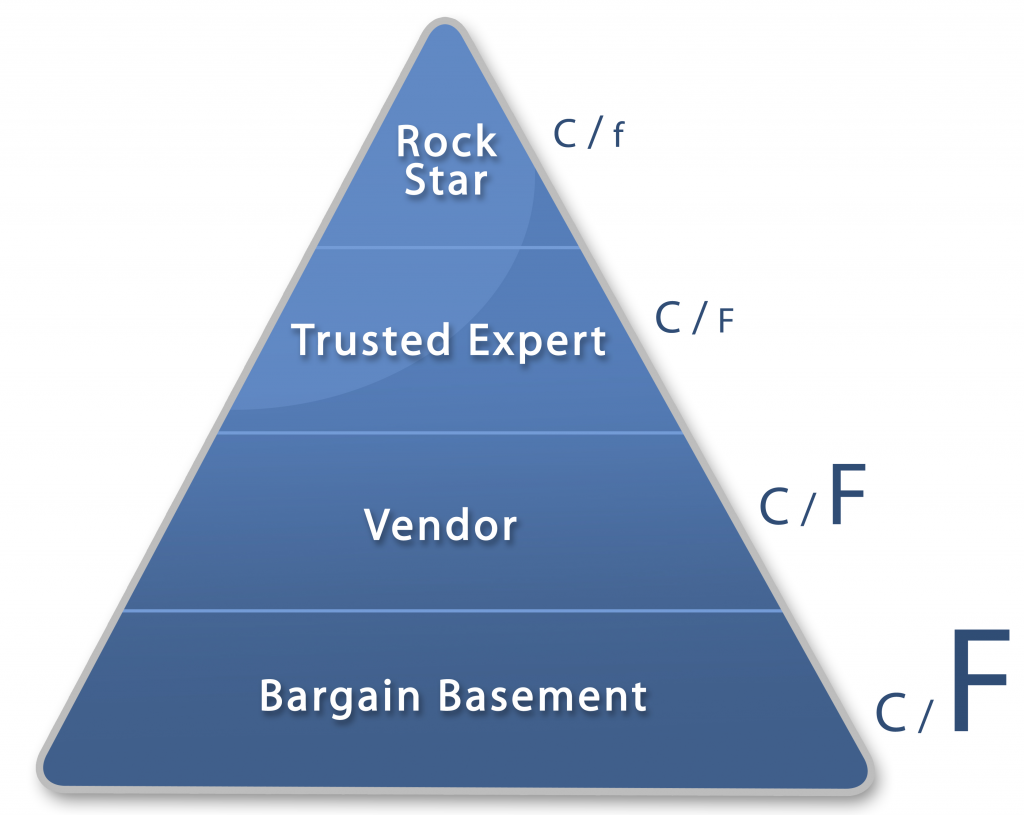According to the comprehensive 2012 Freelance Industry Report, the biggest challenge facing freelancers is landing clients: 37% named that as their top challenge.
Other surveys we’ve conducted at International Freelancers Academy show similar results. One of them revealed that attracting more, better, and higher-paying clients was by far the top challenge for 53% of freelancers.
I wanted to address this pressing issue in this episode, because I believe that the common view and attitudes about attracting and landing quality clients are simply misguided. They’re based on a limited view of reality, and they’re destroying freelance businesses every day.
In this episode I will:
- Explain why the common view and attitudes about attracting and landing quality clients are completely warped.
- Discuss why a new view or paradigm about client attraction is desperately needed.
- Show you what this new view and model are all about and why you need to adopt the mindset that comes with it.
The notes that follow are a very basic, unedited summary of the show. There’s a lot more detail in the audio version. You can listen to the show using the audio player below. Or you can subscribe in iTunes or on Stitcher to get this show delivered straight to the Podcasts app on your smart phone, tablet or iPod.
This Challenge Has Deeper Implications
This challenge creates a vicious cycle. When you have little or no work, you’ll often take on less-than-desirable clients or projects, just so you can pay the bills. Or you’ll quote fees that devalue your work or put you in a very tight spot, because now the client expects you to keep doing more work at that rate or at those levels.
Your self-confidence will often plummet—and that shows when you talk with prospects or quote a project. Or you may even be forced to take on a part-time job to make ends meet.
These are the types of things that can quickly put you on a downward spiral that’s VERY difficult to escape from.
I know this from personal experience. I described one of my own dry periods in episode #6.
Are You Working Under Any of These Dangerous Assumptions?
Looking back at these difficult periods in my freelance business, I now realize that the reason I struggled for so long to climb out of this mess is that I had subscribed to one or more self-limiting beliefs and assumptions.
- The first of these dangerous assumptions is that there’s just too much competition out there. That there are just too many freelance writers in the market, and that this is bringing down rates and fees, and there’s just no way to counter this.
- The second dangerous assumption is that the difficult economy is putting a squeeze on everyone and is making it VERY difficult (or even impossible) to land good projects at good rates.
- The third is that websites such as Elance, oDesk and Guru.com are commoditizing freelance work by creating an ultra-competitive environment. The same could be said about content mills and how they’re commoditizing freelance writing services.
- Finally, there’s the belief that clients are just not valuing the work you do anymore. That they’re having a hard time justifying paying you the fees or rates you quote.
These are all very legitimate concerns. And they’re very common. But they’re based on a very limited view of reality—and it’s killing freelance businesses every day! So if you buy into any of these beliefs, you need to let it go. And I’m going to show you why.
Why the Economy is Irrelevant
The overall economy doesn’t have to have a big impact on your freelance writing business. The diversification principle is on your side!
Diversification principle: a sample size of 30 or larger will give you statistically valid results. A smaller sample size (say, under 10) is not enough to predict your overall results.
And, since you can only take on 3 – 6 clients as a freelance writer at any given time, the performance of your freelance business does NOT need to be directly tied to overall economic conditions or to forces that are affecting the industry in general. And even when those forces DO have an effect on your business, the impact is temporary and can be changed fairly quickly.
Diversifying Will Actually HURT You
Let’s take a large business like Honda Motor Company. Honda has millions of customers around the world. So when there’s a dip in the overall global economy, their sales are affected. And when there’s a spike in global economic growth, their sales are also affected, this time in a positive way.
Why? Because when you have millions of customers, how well those customers are doing from a financial standpoint is a mirror of how well (or poorly) all other car buyers are doing.
Let’s take a smaller business. Say, a marketing firm with 30 or 40 clients. Here again, when the overall economy declines, this small firm will probably feel the effects. Why? Because it has enough clients to mirror what’s going on out there.
Now let’s take a traditional freelance writing business: a business of one. Most of us can realistically work with maybe 3 to 6 clients at any given time. That’s not a big-enough sample size to mirror the overall economy!
And that’s good! Because it enables you to create your own “micro economy.”
If you create a client-attraction system that feeds you with a handful of quality prospects every month or every quarter and yields enough clients every year to keep yourself booked to capacity, you will NOT be affected by overall economic conditions.
So, the point here is that in the freelance world, diversification is not a necessity. In fact, it can even HURT you.
The Freelance Opportunity Pyramid
There’s also a fundamental misunderstanding about the dynamics of the freelancer market.
To better explain this idea, we need to look at what I call the Freelance Opportunity Pyramid. This is a very important tool, and it’s loosely based on a model that my colleague Steve Slaunwhite developed for pricing project-based services.
Here’s the premise of the pyramid: Not all freelance work is created equal. And not all clients have the same needs, expectations, or willingness to pay good fees. Instead, what you typically see out there are four different levels of client work and fee levels
The first of these is the Bargain-Basement level. This is where a big chunk of the freelance work resides. So at first sight, it may appear as though this is where you want to compete. But the fact that there’s so much work here doesn’t mean that it’s the kind of work you want. It’s very low-paying!
As if the fees themselves weren’t bad enough, in this level, there are MORE freelancers competing for work than there are projects available (hence the small “C” and the big “F”).
It’s completely disproportionate. Just look at the numbers on Elance alone! These were the numbers on their home page about a year ago. It’s a ten-to-one ratio!

The next level in the pyramid is the Vendor level. Clients in this space are not necessarily looking for bargain-basement work. They want better quality and are willing to pay more. But they treat freelancers as just “vendors.” In other words, as service providers that are all more or less the same and can be replaced easily or shopped around anytime.

So they may not put the project out there for a hard bid. But they’ll reach out to 4 or 5 freelancers and ask each of them to quote the work. Then, they’ll pretty much take either the lowest bidder or one of the lowest.
As you can see in the pyramid, while there are fewer freelancers competing in this space, the client-to-freelancer ratio still works against you.
Interestingly, by changing your strategy, approach and effort just slightly, you could land in a much better place:
The Trusted Expert Market
The Trusted Expert market is a great place to be in. This is where you start seeing an inflection point in the client-to-freelancer ratio. It’s the first place in the pyramid where there are more clients than freelancers.

In this space, clients aren’t interested in getting bids from 5 different services providers. They don’t have the time or desire to do that. Instead, they choose a freelancer they want to work with, and they stick with them. Price is a factor, but only one factor out of 4 or 5 other key considerations.
This Trusted Expert is a place where clients handpick service providers who know what they’re doing and can prove it. Service providers who have a track record and proven expertise. They know the business very well and deliver value, always submit deliverables on time and as promised, and are a true pleasure to work with.
Finally, there’s the Rock Star level. This is the very top of the pyramid. As you can see here, there are only a handful of clients available. And there are even fewer freelancers who qualify. It’s definitely a great place to be, but 99 percent of the freelancers in that category got there via the Trusted Expert route.

Regardless of whether you freelance full time or part time, your goal should always to position yourself and work in the Trusted Expert level.
Why? Because this is the first level in the pyramid where you can truly maximize your earnings. This is where you can start earning what you need to earn to have more fun, freedom and flexibility in your business and your life.
How Do You Reach the Trusted Expert Level?
- Developing absolute clarity about your ideal client
- Going after “hungrier markets”
- Developing a systematic way to attract great clients
- Delivering extraordinary service
Let’s go through each of these four “key pillars” in more detail…
#1: Developing Absolute Clarity About Your Ideal Client Profile
One of the secrets to having great clients, enjoying your work and earning a higher income is to get clear about the type of client best suited to you. Because once you know exactly who you’re looking for, everything else can fall into place.
But all this starts by being very clear about whom your ideal client is. This could be a person or organization you’ve already worked for, or a fictitious pie-in-the-sky persona.
Let me give you an example of one of my ideal client profiles.
My first ideal client is a medium-size-to-large software company. My primary contact has a significant amount of decision-making ability. She (or he) can make copy decisions on her own without resorting to a review committee. She also knows what she’s looking for, and she consistently communicates her needs and requirements. Furthermore, she values me as a key member of her team, so my fees are not an issue. She sees them for what they are: fair and reasonable, especially considering the unique perspective I bring to the table as an experienced marketer and sales professional (I spent 12 years in corporate sales). Finally, my ideal client has a steady stream of work for me. She doesn’t come to me with just a one-time need. Once she sees the quality of my work and the results I help produce, she continues to send work my way.
Notice the level of detail in this profile. The more detail, the better. Also, you don’t have to have just ONE ideal client profile. You could have two or three.
This “clarity” exercise can be valuable for any freelance writer. But it can be particularly valuable for those of you who have been freelancing for a while (2+ years).
So, if you’re new to freelancing, I would still run through this exercise. But you may want to come back to it after you’ve been out there 2 or more years and see how your view of your ideal client has changed.
#2: Go After “Hungrier” Markets
Look for “hungrier” markets you could serve. By “hungrier” markets I’m talking about markets would be willing to pay more for your services. In many cases, offering the same or similar services to other audiences can double or triple your freelance income. All without working any more hours than you are today.
Example: Pat Baird, a registered dietician who has worked on her own for 23 years. Rather than struggling in traditional dietician markets (with her nutritionist colleagues), Pat earns a very nice living working for major healthcare and pharmaceutical companies and their PR agencies.
And rather than providing traditional nutrition services, she does consulting work, writes white papers and web articles, makes speeches, produces TV segments and serves on advisory boards. She also teaches nutrition at an adjunct to two colleges. She’s thriving!
If you’re a journalist struggling to land work with magazines and trade publications (a rapidly dying market), how about going after case studies and white papers in industries or topics you find interesting?
Or if you’re a copywriter who typically goes after small local businesses, how about shifting some of your prospecting towards midsize corporations that already have budgets for content marketing projects?
Before you start looking for these hungrier markets, you first have to understand how clients prioritize their budgets and how shifts in budgets in priorities impact their demand for your writing services.
Where Are Budgets Shifting?
Most clients prioritize their internal projects on a scale. Each specific project (whether it’s a web redesign project, a new promo video, a translation project, etc.) is either:
- Nice to have
- Important
- Urgent
When the economy is strong, people and organizations spend money in all three categories. But when conditions deteriorate, priorities change. Budgets become more focused on “Important” and “Urgent” items. “Nice to Have” projects are put on hold or scrapped altogether.
In a tough economy freelancers simply CANNOT afford to:
- Go after projects that aren’t considered “Urgent” or “Important” by their clients.
- Go after prospects that provide primarily “Nice to Have” services to their own customers.
Note that I’m talking about the products or services your prospects provide THEIR customers.
Today, all of my clients sell products and services that tackle “Urgent” issues for their own customers and target markets. As a result, they’re relatively recession-proof — which in turn helps keep my own business relatively recession-proof.
So you need to go to where they already “get” the value of a great business writer or copywriter. Go to where there’s an existing (strong) demand. Where they truly value the types of pieces you write.
You need to go where they’re starving!
#3: Develop a Systematic Way to Attract Better-Paying Clients
The third freelance marketing pillar is to develop a more systematic way to attract better-paying clients. And you do that by:
- Using proven and reliable marketing tactics that yield disproportionately high results when compared to the effort, time and money required to execute them.
- Getting into the habit of using these tactics by making your marketing efforts practical and doable.
One of the biggest reasons marketing efforts go nowhere is most freelancers don’t have a systematic way to prospect for clients. What’s needed is a framework for making smart decisions about where and how you spend your limited resources.
That’s where the Marketing Effectiveness Matrix™ (MEM) comes in.

The MEM, which I cover in detail in my book The Wealthy Freelancer, classifies the most common prospecting tactics by how effective they are and how much time they take to develop and execute. The MEM helps you make prospecting decisions based on your specific goals and your unique situation.
- Quadrant 1 contains lead generating tactics that tend to be highly effective and time-efficient.
- Quadrant 2 contains tactics that are also very effective but require more time to develop and execute. Regardless of your goals, most of your efforts should revolve around these first two quadrants.
- Quadrant 3 contains tactics that could work well, but you have to be very selective, as these tactics are often less effective than the tactics in the first two quadrants.
- Finally, Quadrant 4 contains mostly wasteful tactics. They take too long to carry out. They also deliver questionable (or very little) value.
Once you understand how these tactics are classified, you can use the MEM to make prospecting decisions that work best for you and suit your goals, skills and personality. But try to stick to marketing tactics contained in Quadrants 1 or 2. These tactics will yield the best results for your time and effort.
Set Aside Time Every Week
Finally, the best way to ensure your marketing gets done is to schedule time for it. Treat your own marketing as an actual client project. In fact, it’s a project for your most important client — you!
At a minimum, commit to spending 10 percent of your workweek on marketing-related activities. Do that consistently and you’ll quickly gain the critical mass you need to attract all the business you want.
#4: Deliver Extraordinary Service
Everything else being equal, the freelancer who’s the most pleasant, professional and a real joy to work with will land (and keep!) the client. He or she will also get more referrals and get invited to more opportunities.
How can you become easier to work with?
#1: Act professionally at all Times. Clients expect a certain level of professionalism from the people and businesses they work with. They expect clear and professional communications from their vendors and freelancers. They expect to be kept abreast of their progress on a project. They want to deal with people who are pleasant, both in person and on the phone. And they want to work with folks who have a cheerful can-do attitude.
#2: Do What You Say You’ll Do. Similarly, clients want to work with freelancers who don’t require babysitting and constant handholding. As a freelancer, this means meeting all your deadlines … and ALWAYS doing what you say you’ll do. Of course, this also means you’ll have to set the right expectations on every project. But once you make a commitment, you must keep it. Plain and simple.
#3: Be Flexible. The project plan will not always be perfect. You might be a bit delayed because someone in the client’s office is unreachable. A certain phase might get pushed back. Or the scope might change considerably after the project has begun. Those things happen. That’s why you need to be very clear in your contract about how you’ll handle such contingencies.
However, the difference between average and top-earning freelancers is that the true professional will take all factors into consideration and always come up with a creative win-win situation rather than complain or threaten the client.
#4: Take an Active Interest in Clients’ Businesses. I love my clients. And because of that, I take an active and sincere interest in their businesses. I want to learn more about what they do and why they’re better than their competitors. I also enjoy getting to know their people, history, culture, goals and strategic plans. This has paid off in a huge way. My clients tend to be loyal and not very price sensitive.
Enjoyed This Training? Want More?
Want to get more tips and strategies for boosting your writing income? There are three ways you can enjoy these tips and strategies, share them with friends and help me grow this movement to banish the starving writer syndrome:
- Sign up for this podcast on iTunes. Click here to subscribe to the podcast on iTunes.
- Subscribe to this podcast through the Podcast app on your iPhone or Android phone (free from the app store).
- Leave a review — Share an honest sentence or two about the show on the iTunes page and give it a star rating (this makes a HUGE difference in helping others find the show).
- Share the love — Share this episode with friends and colleagues. An easy way to do that is by using the social media buttons down below.
Finally, if you have a question you’d like answered on a future show — or if you have any feedback in general — please let me know: ed at b2blauncher dot com.
Thanks again for your support!
Till next time,
-Ed







